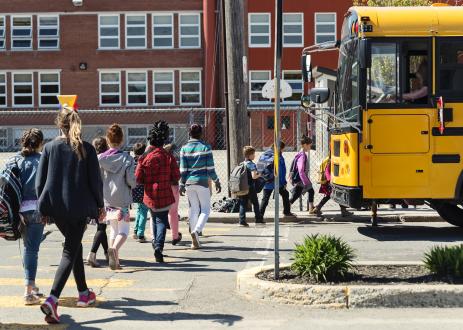Electric School Bus U.S. Market Study and Buyer’s Guide: A Resource for School Bus Operators Pursuing Fleet Electrification
该综合指南为学区和其他人提供了电动校车市场的概述和目录(“买方指南”),该目录(“买方指南”)介绍了今天提供的带有详细车辆规格的电动校车型号。
This publication is intended to serve as a resource primarily for school districts and transportation directors exploring school bus electrification and provide them with a better understanding of the state of the electric school bus market and available offerings. It aims to present the growing interest and investment in the sector along with key aspects of the current technology. A scan of the market explores the growing demand for these buses and how manufacturers are positioning themselves to meet that demand. The catalog presents electric school bus models available today with detailed vehicle specifications allowing readers to compare various models and weigh important considerations.
强调
- 美国各地的学区已经开始过渡到电动校车(ESB)。截至2022年3月,有415个地区(或私人车队运营商)承诺在38个州和一系列运营条件下使用12,275个ESB。各州和市政当局正在设定电气化目标,而制造商规模生产。
- Compared to the typical school bus that runs on diesel fuel, ESBs have the potential to lower operation and maintenance costs for fleets and have zero tailpipe emissions. Their large batteries can store and deliver energy using “vehicle-to-everything" technology, to power buildings and other devices, which can support greater resiliency including through the integration of renewable energy. ESBs also have the potential to generate revenue by discharging energy from their batteries back onto the grid, lowering utility costs and emissions. Though this is a nascent market, technological advancements are due to make this widely available in the near future.
- 目前,有22种ESB型号可从12种用于A型,C和D型巴士的制造商提供:14个新制造的车辆型号和8种重新播放的车辆型号。A型模型的选择最多。C型型号是商业上最好的准备。
每一代公共汽车都比以前更先进:许多制造商都在第二次或第三次迭代中,有些甚至进一步。当前的电动校车型号的铭牌范围从75到210英里,足以可靠地覆盖大多数运行的路线。
语境
Momentum around electric school buses (ESBs) is growing in the United States as school districts across the country transition to this cleaner and healthier technology, bolstered by an upcoming infusion of new funding from the federal government. The ESB transition will require a coordinated effort among numerous entities, including school district leadership and staff; school bus manufacturers and contractors; utilities; policy makers; regulators; local advocacy organizations; and community members.
该出版物旨在主要用于学区,运输总监和其他校车运营商探索校车电气化的资源,以更好地了解ESB市场和可用产品的状态。它的目的是介绍当前技术的关键方面,对该行业的兴趣和投资日益增长。在“电动校巴市场的地位”部分中,我们探讨了对这些公共汽车的需求不断增长,以及制造商如何通过扫描市场来满足需求。接下来,在“公交基础知识”中,我们解释了ESB的关键组成部分,并讨论支持这些公交车所需的充电和相关基础架构。该出版物的核心要素介绍了截至2022年初的22种ESB模型的目录,其详细的车辆规格使读者可以比较各种模型并权衡重要的考虑因素。我们通过总结迄今为止校车电气化的状态来结束。
Approach and Methodology
该出版物的内容是从各种来源收集的,从美国可用的车辆规格表中收集了有关模型的信息,并在可能的情况下通过与公共汽车制造商的讨论确认。
我们探索代表美国各种用例的ESB的学区经验 - 农村,郊区和城市;温暖和寒冷的天气,包括高温;以及早期采用者以及采购阶段的过程。我们汇编了有关学区承诺和经验的最新研究和报告,并通过与学区和其他合作伙伴进行对话补充了公共信息。我们计划随着新车进入市场的每年更新该出版物,并改变了现有型号。
This resource is one of many from WRI’s Electric School Bus Initiative and is intended to be updated to expand upon topics like funding and financing, alternative service models and utility engagement.
Text in this Issue Brief was corrected on August 18, 2022. The statement that the range of current electric buses can cover 99% of school bus routes across the country was revised. It was replaced with a statement that the range of current electric buses cover most school bus routes. The citation was removed from the references list.
Projects
-

电动校车计划
启动平台启动平台 Visit ProjectCollaborating to equitably electrify the U.S. school bus fleet.
Part of Cities


